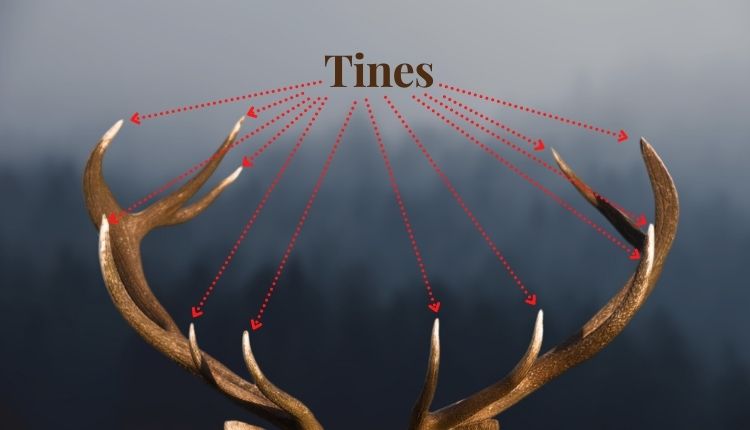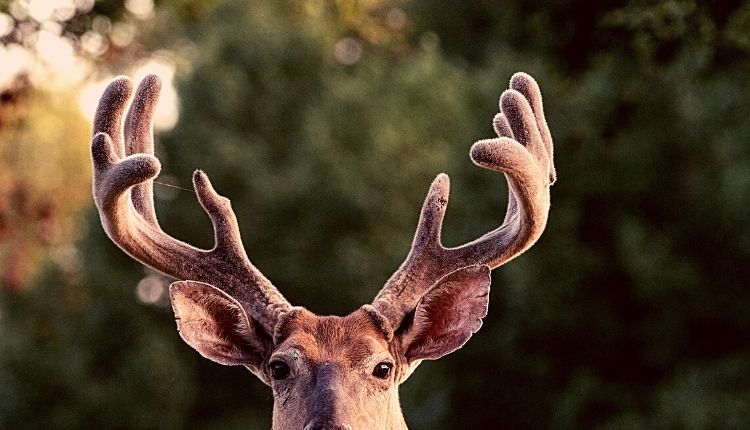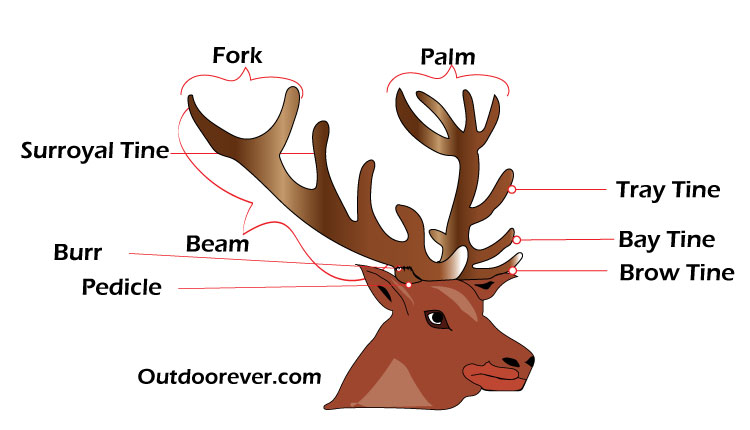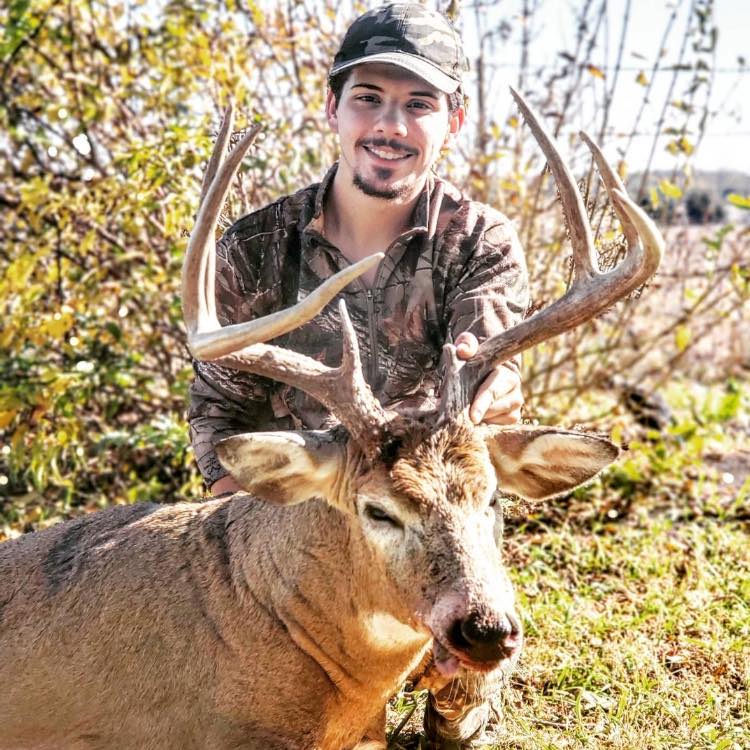Few things are more prized than 12-point bucks by deer hunters. And the truth is we all want to bag ourselves a 12-point buck. But What Are 12-Point Bucks exactly mean? To answer this question, we need first to understand what points are on a buck.
Points refer to the individual tines on a buck’s antlers. Bucks with 12 points or tines on their antlers are prized more than those with fewer points. So 12-points bucks mean the buck has 12 unique tines on his antler. Typically bucks with 12 points are mature, aged between 5 and 7 years.
Antlers usually have a distinct physical appearance. And it is this distinct physical structure of the antlers that are used to differentiate bucks from does.

Do All Deer Species Have Antlers?
The short answer is no. Not all deer species have antlers; the Chinese water deer and the Musk deer do not have antlers. On the flipside, both female and male reindeer or caribou grow antlers.
Antler formation process
Deer have a permanent outgrowth on their skull’s front bone known as a pedicle. It is from this outgrowth that antlers grow. The pedicle is surrounded by a membrane known as a periosteum responsible for antler growth.
A rise in testosterone in a buck’s blood causes antlers to develop. This occurs when minerals, typically calcium and phosphorus, are deposited on the pedicle area. This deposition of minerals causes the tissue to start turning into bones.
In late August and early September, the pedicle becomes surrounded by a dense layer of skin, typically called velvet. As testosterone levels rise deep into summer, the deer shed the velvet skin.

Also, the arteries and veins to the pedicle area constrict, restricting blood flow to this area. This causes the velvet to dry, further revealing the bony material underneath. You will find male deer rubbing their growing antlers against trees during this time.
They do this to get rid of dead tissues before transitioning to the rutting season in late October to November. In early fall, the antlers become visible and are usually white or brown.
White antlers or racks are usually caused by the blood-rich velvet drying out quickly, and thus the deer do not have to rub against anything to shed off the dry velvet. If the velvet dries slowly and the deer start rubbing their growing antlers against trees, it results in a brown stain.
The brown color can sometimes be caused by deer rubbing their growing racks against certain types of trees and shrubs.
When do antlers start growing
Antlers on male deer start growing in late March and sometimes early April. Their growth is typically preceded by the growth of two bony stumps on the deer’s pedicles.
When do they shed their antlers?
Deer antlers do not last forever, and after some time, the deer will shed their antlers. After the rutting season, hormonal changes cause the deer to shed their antlers. This typically happens early in December.
However, the shedding may occur as late as March in some areas. In others, it may appear around January or February. Generally, the shedding will occur between December and late March. Bucks shed their antlers due to a drop in testosterone levels required during mating.
After mating, the buck’s testosterone levels drop. The antlers may stay for longer if there are more does in heat.
Main parts of a deer antler
The antlers have different parts; these parts are
- Pedicle: The pedicle is the part where the antlers are connected to the skull
- Beam: The beam is the central stem that makes up the antlers and from which the tines grow.
- Burr: this is the bony rim of the pedicle
- Brow tine: this is the first point from which the first antler branches off.
- Bay tine: refers to the second branching off point of the antlers
- Tray tine: Is the third branching off point
- Surroyal tine: this is the fourth branching off point and is usually on a separate tine
- Fork: is the end of the antlers and branches off into two tines
- Palm: Typically found in moose, the palm is a part of the antler that resembles the palm of a human hand.

Why Is Deer antlers Point important?
Deer antler’s points are important to hunters but also to biologists. For hunters, antlers are a prized possession you can use to show off your hunting prowess. And antlers are also used as decorations in our living rooms and even on our cars.
However, there is another reason why antlers are important to hunters. There are laws on what kind of deer you can hunt in some states based on their antlers. This means there are laws specifying the number of points on a deer you can hunt.
Therefore studying deer antlers will help you be on the safe side of the law.
To biologists, antler’s points are used to indicate the growth of deer they are studying and the overall conditions. In years of good weather and conditions, antlers have better antlers.
However, in years with bad weather and poor conditions, antler growth is usually poor. Thus antlers can be used to study the living conditions of deer in a given area.
How Count A Deer’s Antler Points
Given the prestige of 12-point antlers, it is important to know how to count them if you have bagged yourself a 12-point buck. Here is how to count the number of points on antlers.
- Step One: Using a flexible measuring tape, measure the length of each tip that protrudes from the main antler beam. The tip is considered a point if it is at least 1 inch long.
- Step Two: measure any additional tips that extend from the tips you have measured. The tips need to be at least 1 inch long to be considered a point.
- Step Three: include the brow tines, which are the small tips that angle forward over the animal’s eyes if it is a whitetail deer. For mule deer, these tips are not counted.
- Step Four: After measuring all the tips, count them for both antlers and add a point for the tip of the main beam. The total you get is the number of points the antlers have.
The Boone and Crockett system of measuring
While measuring and counting the number of points a deer has is all well and dandy, a more universal and standard way of measuring will give you a more accurate number. Also, it will make it easier to compare your kill with other hunters. This is where the Boone and Crockett system comes into play.
So how does it work? Glad you asked. The Boone and Crockett system takes into account several things that I have outlined below.
Measure the circumference
The first measurement you need to take is the thickness or circumference of the main antler beam. Use a flexible steel cable or a ¼ inch flexible steel tape. You need to measure the thickness in four different parts.
First, measure the thickness of the thinnest part, which is between the antler’s base and the first point. Next, get the remaining three measurements by measuring the thickness of the center spot between the remaining points.
If the deer has less than three points, measure the thickness between the third point and the tip of the main beam as your fourth circumference measurement.
Measure the spread
Next, you need to measure the width between both antlers. To get this measurement, measure the width of the widest points between the two main beams.
Identify the symmetry category
Antlers are classified into two categories: typical and non-typical. A typical antler has the same number of points on both antlers. On the other hand a non-typical has a different number of points on the two antlers. While these types of antlers are rare, they are graded differently.
Measure the points
Now it is time to measure the points. The first thing to do is measure down the middle of the main beam. Start from the edge of the main beam all the way to the tip. Record the measurement to the closest ⅛th of an inch. Record the length of the main beams.
Then measure the length of each point that protrudes from the main beam using the same steel cable. The tip will be marked as a point if it is at least 1 inch long. Any additional tips that break off, the main tips are measured and added to the scoring sheet separately.
Get the differences
Not the differences in measurements between the two antlers. Take the length and circumference of the two beams. Then take the largest measurement of two and subtract the smaller measurement from it.
Get the score
Add all the measurements for the final score. If there are any differences, subtract it from the score; if the buck had additional tips, add the tips to the final score too.
Official score
Once you have your final score, wait for the antlers to dry in about 60 days, when officials will re-do the measurement and give you your official score.
Factors that affect the overall number of points on a buck’s antler
Several things will influence the total number of tips an antler will have. The main factors are.
Vitamins and minerals: Nutrition Plays An Important Role
The availability of nutrients in a buck’s diet will influence how long the antlers grow and the number of tines on them. Bucks develop shorter antlers with fewer tines in areas with large herds where competition for nutrients is high. Calcium and phosphorous are key nutrients they need to establish healthy antlers and tines.
Age
Young bucks have shorter antlers with less points, and the antlers grow as they age. Therefore, older bucks aged 4 to 8 years will have more points and larger antlers. The peak age of antler growth for mule deer and whitetail deer starts from about 5 years and continues as it’s getting old. On the other hand, the full growth potential of Elk antlers does not reach its maximum until the animal reaches 8 years of age. Meatier-aged bucks with big blocky antlers have a major advantage over younger bucks in challenging and defending territories, as they can fight to keep their territory during improved mating strategies that are provided by most mature bulls.
Genetics
A deer’s family history and genetics will also affect the length of its antlers. Selective hunting can be a great way to minimize genetics-related problems. The Boone and Crockett class of animals is known for its large racks, but not all genetically gifted deer or bull reach their potential. Some factors that can limit a deer’s ability to rack up big numbers are poor diet and over-hunting.
Differentiating 12-point bucks from other bucks
12-point bucks are different from other bucks in their age and physical appearance. These bucks are typically aged between 5 and 7 years old. The main physical differences between them and other bucks are;
1-year-old bucks:
One year old bucks typically have thinner necks and longer legs. Also, their legal appear longer than their bodies, which makes them appear lean. They also have a line separating their shoulders and necks while having narrow waists.
In terms of their antlers, they typically have short, thin beams for antlers.
2-year old bucks:
Bucks aged two years have long legs that make them look awkward and gangly. They also have thin waists and slightly built-up neck muscles. At this age, the antlers are usually as wide as the ears.
3-year-old bucks:
3-year-old bucks are identifiable by their thicker necks and shoulders compared to younger bucks. Also, a buck’s chest is deeper than its hindquarters at this age. They still have a thin waist, though.
4-year-old bucks:
At 4-years old, bucks start showing signs of full maturity, and their shoulders and necks become thicker than those of 3-year-old bucks. Their waist has a drooping appearance.
5-7-year-old bucks:
Bucks aged 5-7 years have some physical resemblance to bucks aged four years. The main difference is that older bucks have sagging stomachs and look like small cows with increased body mass.
8-years and beyond:
Bucks aged eight years and over are considered beyond mature and past their prime. The skin around their faces and necks appears loose, and their hip bones are more exposed.
Frequently Asked Questions
Can the size of the antlers tell you how old a buck is?
Yes, bucks with large antlers with ten or more points are usually aged 5-7 years. Young bucks aged 2 or 1 years typically have small stumps on their heads.
How many points does the biggest point buck have?
According to the Boone and Crockett Club, the buck with the most number of points has 213-⅝ points.
What is the total number of points a buck can have
The number of points a buck can have varies depending on genetics and nutrition. Bucks with inferior antler genetics typically don’t have more than 8 points.
Should I count the points in both antlers?
This boils down to preference in some states; it is standard practice to count the points on both antlers. In others, however, points are calculated on one antler.
Conclusion
Being able to tell whether a buck is a 12-point or not is crucial for you as a hunter, obviously, for the prestige that comes with bagging such a prized buck. But also, hunting bucks that are mature only will help keep their population in check and avoid hunting younger bucks.

About The Author:
Lake Streeter, A Gun enthusiast, and loves to hunt in the middle of the wood. Always check the latest hunting gears out in the market and try to share his honest opinion with the audience in Hunting Nook.
